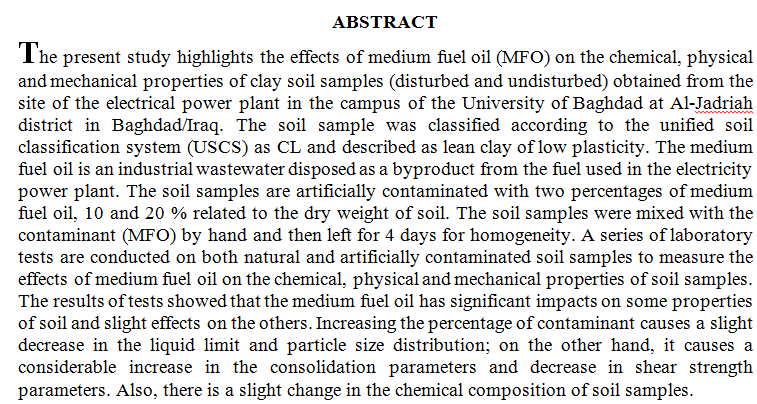
Soil invertebrates community an important role as part of essential food chain and responsible for the decomposition in the soil, helps soil aeration , nutrients recycling and increase agricultural production by providing the essential elements necessary for photosynthesis and energy flow in ecosystems.The aim of the present study was to investigate the soil invertebrates community in one of the date palms plantation in Aljaderia district South of Baghdad, , and their relationships with some physical and chemical properties of the soil , as Five randomly distributed replicates of soil samples were collected monthly. Invertebrates samples were sorted from the soil with two methods, direct method to isolate large invertebrates and indirec
... Show More (12)
(12)
 (7)
(7)
Liver is considered as the first target for the toxic effects of toxins and other xenobiotics, and this can be attributed to its role as a site which receive all absorbed xenobiotics from the gastrointestinal tract and its role as a major site for biotransformation of xenobiotics. The present study was designed to evaluate the possible hepatoprotective effect of benfotiamine against CCl4-induced hepatotoxicity in rats. The study was conducted on 48 male albino rats; the animals were allocated into 8 groups (6 rats in each group) and treated as follow: 4 groups treated with oral doses of either normal saline, benfotiamine (100 mg/kg), thiamine (100 mg/kg), N-acetylcystein (400 mg/kg) only without induction of hepatic damage. Th
... Show More (1)
(1)
The objective of the study: To diagnose the reality of the relationship between the fluctuations in world oil prices and their reflection on the trends of government spending on the various economic sectors.
The research found: that public expenditures contribute to the increase of national consumption through the purchase of consumer goods by the state for the performance of the state's duties or the payment of wages to employees in the public sector and thus have a direct impact on national consumption
The results of the standard tests showed that there is no common integration between the oil price fluctuations and the government expenditure on the security sector through the A
... Show MoreBackground: Poly (methylmethacrylate) is the most widely used material in denture fabrication. The characteristics of acrylic resin which support microorganism development can threaten the oral health of denture users. This study was assigned to prepareand incorporate Ag-Zn zeolite powder into heat cured denture base material as antimicrobial material and to investigate its effect on some properties of heat cured acrylic denture base materials. Materials and methods: Sliver –zinc zeolite was prepared by ion exchange method and characterized then incorporated into poly (methylmethacrylate) powder in0.5% by weight. Specimens were constructed and divided into 6 groups according to the using tests; each group was subdivided into 2 groups
... Show MoreBackground: The geriatric patients wearing removable partial dentures are increasing in proportion. At the same time, the root caries prevalence accompanied by gingival recession is increasing. A variety of vehicles can deliver fluoride into the oral cavity, including fluoride mouth-rinse, fluoride dentifrice, topical fluoride, and fluoride-releasing restorative materials, all of which effectively prevent root caries and suppress recurrent caries. This study aimed to evaluate the effect of sodium fluoride addition on some mechanical properties of heat cure acrylic denture base material. Material and method: A total of 90 samples were prepared in this study, then divided into three main groups according to the type of test used (hardness, te
... Show MoreBackground Microorganisms and fungal growth especially Candida albicans, on soft denture lining material are the most common problem which can lead to chronic mucosal inflammation. The aim of this study was to evaluate the effect of zirconium nanoparticles into acrylic-based heat cured soft denture lining material against Candida albicans, and the amount of zirconium ion release of soft liner/ZrNPs composite. Furthermore, evaluate shear bond strength after ZrNPs addition to soft liner. Materials and methods: Zirconium nanoparticles were added into acrylic-based soft denture liner in various percentages (1%, and 1.5% by weight). Two hundred and fifty specimens were arranged and isolated into four groups as per the test to be done The antifu
... Show More (16)
(16)
Friction stir welding (FSW) process is an emerging solid state joining process in which the material that is being welded does not melt. This process uses a nonconsumable tool to generate frictional heat in the abutting surfaces. The welding parameters such as tool rotational speed, welding speed, axial force, etc., and tool pin profile play a major role in deciding the weld quality. In this investigation an attempt
has been made to understand the effect of tool pin profile and rotation diameter on microstructure and mechanical properties in aluminum alloy (2218-T72). Five different tool pin profiles (straight cylindrical, threaded cylindrical, triangular, square, and threaded cylindrical with flat), with three different rotation
d
 (5)
(5)
